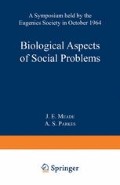Abstract
Studies in a number of different countries, which have shown that rates of mobility between different occupational classes are more alike than they were expected to be, have raised questions about the mechanisms underlying social mobility. In preparation for a large-scale investigation, we have made two small pilot studies designed to clarify certain preliminary problems. In the second half of this paper we are going to concentrate on the second pilot study, whose concern was with fertility. Before proceeding to that discussion we shall in the first part give a brief outline of the main idea we hope to explore in the large-scale investigation. It has been rather more fully developed elsewhere.29
Access this chapter
Tax calculation will be finalised at checkout
Purchases are for personal use only
Preview
Unable to display preview. Download preview PDF.
References
Anastasi, A. 1956. Intelligence and Family Size. Psychol. Bull. 53, 187.
Anastasi, A. 1959. Differentiating Effects of Intelligence and Social Status. Eugen. Quart. 6, 84.
Anderson, C. A., Brown, J. G. and Bowman, M. J. 1952. Intelligence and Occupational Mobility. J. pol. Econ. 40, 218.
Bajema, G. J. 1963. Estimation of the Direction and Intensity of Natural Selection in Relation to Human Intelligence by Means of the Intrinsic Rate of Natural Increase. Eugen. Quart. 10, 175.
Burt, C. 1959. Class Differentiation in General Intelligence. Brit. J. statist. Psychol. 12, 15.
Burt, C. 1961. Intelligence and Social Mobility. Brit. J. statist. Psychol. 14, 3.
Cannon, W. B. 1932. The Wisdom of the Body. New York. North.
Carter, C. O. 1962. Changing Patterns of Differential Fertility in Northwest Europe and in North America. Eugen. Quart. 9, 147.
Cattell, R. B. 1950. Personality: A Systematic Theoretical and Factual Study. New York. McGraw-Hill.
Conrad, H. S. and Jones, H. E. 1940. Yearbook Nat. Soc. Stud. Educ. 39, 97.
Conway, J. 1958. The Inheritance of Intelligence and its Social Implications. Brit. J. statist. Psychol. 11, 171.
Darlington, CD. 1960. The Future of Man. Heredity 15, 441.
Fisher, R. A. 1930. The Genetical Theory of Natural Selection. Oxford. Oxford University Press.
Floud, J. E., Halsey, A. H. and Martin, J. M. 1956. Social Class and Educational Opportunity. London. Heinemann.
Freedman, R. F., Whelpton, P. K. and Campbell, A. A. 1959. Family Planning, Sterility and Population Growth. New York. McGraw-Hill.
Galton, F. 1889. Natural Inheritance. London. Macmillan.
Getzels, J. W. and Jackson, P. W. 1962. Creativity and Intelligence. New York. Wiley.
Glass, D. (Ed.). 1954. Social Mobility in Britain. London. Routledge.
Higgins, J. V., Reed, E. W. and Reed, S. C. 1962. Intelligence and Family Size: a paradox resolved. Eugen. Quart. 9, 84.
Lewis-Faning, E. 1949. Family Limitation and its Influence on Human Fertility during the past Fifty Years. Papers of the Royal Commission on Population, Vol. 1. London. H.M.S.O.
Lipset, S. M. and Bendix, R. 1960. Social Mobility in Industrial Society. London. Heinemann.
Miller, S. M. 1960. Comparative Social Mobility. Oxford. Biackwell.
Penrose, L. S. 1949. The Biology of Mental Defect. London. Sidgwick and Jackson.
Scottish Council for Research in Education. 1949. XXX. The Trend of Scottish Intelligence. London. U.L.P.
Tuddenham, R. D. 1948. Soldier Intelligence in World Wars I and II. Amer. Psychol. 3, 54.
Wiener, N. 1948. Cybernetics. New York. Wiley.
Willmott, P. and Young, M. 1960. Family and Class in a London Suburb. London. Routledge.
Willoughby, R. R. and Coogan, M. 1940. The Correlation between Intelligence and Fertility. Hum. Biol. 12, 114.
Young, M. and Gibson, J. B. 1963. In Search of an Explanation of Social Mobility. Brit. J. statist. Psychol. 16, 27.
Author information
Authors and Affiliations
Editor information
Editors and Affiliations
Rights and permissions
Copyright information
© 1965 Springer Science+Business Media New York
About this chapter
Cite this chapter
Gibson, J., Young, M. (1965). Social Mobility and Fertility. In: Meade, J.E., Parkes, A.S. (eds) Biological Aspects of Social Problems. Springer, Boston, MA. https://doi.org/10.1007/978-1-4899-6580-6_5
Download citation
DOI: https://doi.org/10.1007/978-1-4899-6580-6_5
Publisher Name: Springer, Boston, MA
Print ISBN: 978-1-4899-6268-3
Online ISBN: 978-1-4899-6580-6
eBook Packages: Springer Book Archive

